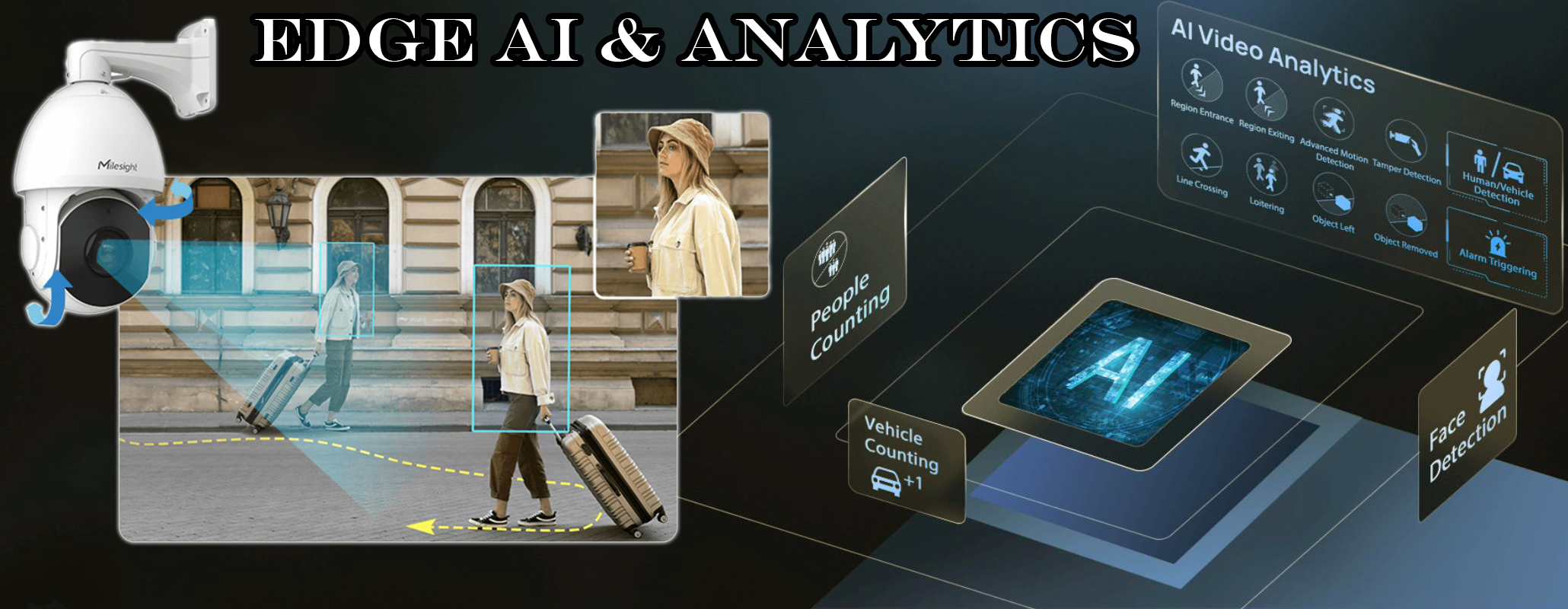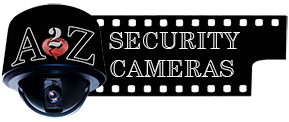Edge AI in IP Cameras — Implementation, Interop & Benchmarking Guide

By Justin C., Video Security System Specialist — A2Z Security Cameras
Last updated: August 18, 2025
New to the history/definitions? Start with the foundation: All About Video Analytics & AI-Powered Analysis for CCTV & IP Security Cameras
This page focuses on edge (in-camera) AI implementation and validation.
TL;DR (edge-focused)
- Edge AI is now mainstream across modern systems (not just remote/off-grid): it reduces false alerts, trims bandwidth/storage via event-driven workflows, and enables faster on-site actions.
- Pairing with NVR/VMS/CMS that support AI metadata unlocks cross-camera search, dashboards, incident timelines, and enterprise workflows.
- Interoperability reality: ONVIF Profile M standardizes metadata format/transport, but parity still depends on what’s published → ingested → exposed. Validate it (checklist below).
- Design for accuracy: aim for people ~80–100 px tall (waist-up ~60–80 px workable); LPR plates 130–180 px wide with angle <30°; stable mounts; smart IR and sensible shutters.
- Performance varies by brand/model. Treat fps, shutter, thresholds, and tracking behaviors as tunables you will pilot on-site.
What edge AI cameras can deliver (varies by model & policy)
- Object & behavior: person/vehicle classification; tripwire/intrusion; loitering; object left/removed; tamper (defocus/moved/covered).
- Identity/compliance: LPR/ALPR for surveillance, investigations, and access workflows; PPE (helmet/vest); limited face/attribute analytics where allowed.
- PTZ automation: AI-enhanced auto-tracking, click-to-track, rule-based re-center; active deterrence tie-ins (lights/sirens/voice-down).
- Actions & recording: relays, schedules, event bookmarks; event-driven/dual-profile recording to cut backhaul/storage while preserving evidence windows.
- Efficiency: fewer nuisance alerts, faster operator triage, and leaner WAN/cellular usage.
Capabilities landscape (neutral, not “good/better/best”)
| Category | Examples | Notes |
|---|---|---|
| Common | Person/vehicle classify; tripwire/intrusion; tamper; event bookmarks | Broadly available across price points |
| Advanced | LPR/ALPR; PPE; crowd/loiter; PTZ auto-tracking; attribute filters (vehicle type/color) | Often needs better sensors/SoC and careful scene design |
| Specialized | Vehicle make/model/color; people re-identification; analytics under extreme low-light or thermal; multi-model concurrency | Model concurrency and firmware maturity matter; verify on-site |
Capability quality varies by brand/algorithm and scene conditions (lighting, distance, motion). Pilot and log results.
Interoperability & Profile M — test checklist (end-to-end)
Goal: confirm each analytic field survives from camera → chosen software/UI.
1) Publish (camera): person/vehicle class, attributes (e.g., vehicle color/type, PPE), plate text, zone/line, confidence, timestamps.
2) Ingest (system): verify your NVR/VMS/CMS or camera web/mobile UI can receive/store each field (check raw metadata/logs if available).
3) Expose (UI): confirm fields are filterable/searchable (not just stored).
4) Limits: note per-channel caps, model concurrency, licensing, and minimum firmware.
5) Artifacts: save 5–10 event clips + a settings export for the site record.
Metadata path matrix (publish → consume → search)
| Field | NVR/VMS consumes | Vendor CMS/App consumes | Camera web/mobile UI | Searchable in UI?* | Notes |
|---|---|---|---|---|---|
| Person/vehicle class | Yes | Yes | Often | Usually | Class facet commonly supported |
| Vehicle color/type | Yes | Varies | Varies | Varies | Stored but not always faceted |
| PPE (helmet/vest) | Varies | Varies | Varies | Varies | Same-brand stacks more complete |
| Confidence score | Yes | Varies | Rare | Varies | Sometimes hidden; affects rules |
| LPR plate text | Yes | Yes | Sometimes | Often | Searchable text in many stacks |
*“Searchable in UI” means user-facing filter/facet—not just visible in a raw log.
Deployment patterns (edge-centric)
- Modern connected sites: edge AI cuts false alarms and backhaul; pair with NVR/VMS for cross-camera search and case workflows.
- Remote/off-grid/cellular: edge detects locally; send event clips/metadata; ANR buffers to SD/NAS and backfills later.
- Gates/parking: embedded LPR + relays simplify access actions; NVR/VMS or CMS adds lists, alerts, audits, and reports.
- Retail/small business: enhanced person/vehicle detections with simple rules; NVR/CMS for multi-camera review and staff notifications.
- Campus/enterprise: edge reduces server load; centralized VMS/analytics for dashboards, trend reports, and incident timelines.
Tips for accuracy in the field (design first)
| Factor | Why it matters | Practical guidance |
|---|---|---|
| Pixels on target | Model needs subject size | People 80–100 px tall (waist-up ~60–80 px workable); LPR 130–180 px plate width; angle <30° |
| Lens & framing | Detection vs detail | Prefer varifocal; avoid ultra-wide scenes that shrink targets |
| Lighting & shutter | Motion blur kills AI | Balanced WDR by day; smart IR/fluid illumination at night; try 1/120–1/250 shutter then tune |
| Frame rate | Motion fidelity | General 15–20 fps; traffic/LPR 20–30 fps |
| Mount stability | False motion | Rigid mounts; damp vibration; avoid poles that sway |
| Masks & zones | Fewer false alerts | Mask roads/trees; draw lines perpendicular to motion; schedule by time/day |
Pilot under worst-case (night/rain/backlight/headlights). Log false positives/negatives before scaling.
Setup starting points (universal, then tune per site)
- FPS: 15–20 (traffic/LPR 20–30).
- Shutter: 1/120–1/250 at night; balance against low-light noise.
- WDR/IR: strong WDR daytime; use smart IR to avoid hotspotting.
- Thresholds: start medium (e.g., confidence 0.5–0.6); increase if nuisance alerts persist.
- Compression/GOP: H.265/H.265+ where stable; test VBR with capped max; GOP ~2–4× fps for efficient scrubbing (e.g., 30 fps → GOP 60–120).
- Bitrate sanity: main stream 1080p/4MP ~2–5 Mbps (scene-dependent); substream 480–720p ~0.3–0.7 Mbps (for previews).
PTZ automation & tracking options (brand-dependent)
- Auto-tracking: camera follows a target based on on-board detection. Behavior varies by vendor (handoff optional, not required).
- Click-to-track: operator picks target; camera tracks automatically.
- Rules-assisted moves: tripwire/intrusion triggers jump to preset/zoom.
- Deterrence combos: coordinate lights/sirens/voice-down with tracking events.
Guidance: set zones/zoom limits, define timeouts to return to preset/tour, store short clips for weekly tuning. Note min/ideal distances and max speeds per product data.
Power, thermal & network (practical notes)
- PoE budgets: confirm per-port and switch totals; AI spikes can cause brownouts.
- Cabling: quality Cat5e/Cat6/Cat6a as distances/speeds dictate; protect outdoor terminations; verify link speed/loss.
- Thermals: check device operating temperature range; sunshields/vented housings help in hot sun.
- Local storage: high-endurance microSD is common; SSD/NAS for heavier duty. Enable media-health alerts if available.
- Network options: VLAN/QoS can help in busy networks but are optional/advanced—most sites don’t need deep tuning to start.
Security & governance (menu of controls — varies by device)
- Hygiene: disable unused services; unique strong creds; TLS if supported.
- RBAC & MFA: roles per duty; MFA on NVR/VMS; audit logs for exports/changes.
- Network posture: isolated VLANs; least-privileged rules; avoid direct Internet exposure.
- Privacy: masking for public views; retention limits; document who gets alerts and where footage goes.
- Maintenance: staged firmware rollouts with rollback.
Not all cameras support all features. Treat this as an options list; implement what your devices support.
Event pipeline, bandwidth & storage (how edge helps)
- Event-driven / dual-profile: high quality near events, lower bitrate otherwise → storage/backhaul savings without losing evidence context.
- Metadata-first search: multi-camera filters (object, attributes, zone/line, time, notes) in the recorder/CMS where supported.
- ANR/backfill: buffer to SD/NAS during outages; backfill on reconnect.
- Evidence kits: bookmarks + exports streamline hand-offs.
Pilot acceptance checklist & scorecard
Definitions: FP = False Positive, FN = False Negative.
| Metric | Guidance (tune per site) | Target (fill in) | Pass/Fail | Notes/Clip IDs |
|---|---|---|---|---|
| Alert latency (edge only) | Sub-second is attainable on many models; varies by brand/network | ______ | ||
| Alert latency (via NVR/CMS rule) | Usually higher than edge-only | ______ | ||
| FP rate (night, Zone A) | Set a realistic band; adjust masks/thresholds | ______ | ||
| FN rate (staged passes) | Verify with controlled walks/drives | ______ | ||
| LPR read rate | Specify px/angle/fps used in test | ______ | ||
| Missed-event count (per 8 hrs) | Track with a paper log during pilot | ______ | ||
| Operator review time/event | Aim to reduce with metadata filters | ______ |
Artifacts to keep: 5–10 clips/scenario, settings export, firmware/model versions, any mask/threshold changes.
Next steps
- Explore recorders: DVR/XVR/VMS/NVR Catalog
- Browse cameras: IP Security Cameras
- Read the foundation: All About Video Analytics & AI-powered Analysis
- Want help drafting a pilot plan for your site? Contact our expert team.
